|
Contents Dust Finish Construction The BC 2000 Guitar woods Alder Bocote Cherry Ebony Horsechestnut Mahogany Maple Mutenye Redwood Rosewood Sitka spruce Spruce Western red cedar |
|
Construction and design I start this page with some words about my design and construction philosophy, before I get somewhat into detail about guitar woods. I usually make steel string guitars like a J-185, a little smaller than the standard "Jumbo" size. But I make other sizes as well: Dreadnaught , "Sloane" (a little smaller and with more waist than the Dreadnought), and one still smaller, this is for a 12-fret neck. The scale I use is 64 cm for a steel string, and 65 cm for a classical guitar. I like the fingerboard to be broader, 45 mm, on a steel string and narrower, 48 mm on a classical. But I will make any scale and any wideness for you at no special price. I prefer ebony fingerboards unless you specify something else. By the way, did you ever try a 12-string with a compensated saddle?
I think my bridge design is pretty nice, but again, I can make other types. And I prefer the Florentine (pointed) cutaway, mainly because I tend to ruin sides trying to bend the sharp curve of the Venetian type. I build classical guitars quite traditionally, but like on a steelstring, I use a dovetail joint between the neck and the body, while the traditional way is to make the neck and neckblock in one piece. |
Dust
I get increasingly less fond of wood dust. As a result of this, I try to use dust-collectors and to use scrapers or other tools that do not generate dust. I used to be no good at sharpening tools, but I am improving. Nowadays, I don't even sand the bracing, I prefer to spend a little more time, sculpting them with a really sharp chisel.
(Contents)
The finish
I used to finish my instruments with nitrocellullose lacquer with a brush and bad ventilation, and now I get cold sweat and nausea with just a sniff of the stuff! Luckily, my brain did not get damaged (you won't notice until it is too late!), and I will not recommend nitrocellullose to anybody unless they have access to a professional spray booth and a fresh-air helmet. Not to mention the fire hazard! You can have nearly as good results with water-soluble lacquers, they get better all the time. I now use a Wagner HVLP outfit (high volume, low pressure, in practice a vacuum cleaner turned the other way) I have a knock-down spray booth. It takes me half an hour to mount it and 20 minutes to tuck away. I use Crystalac that I buy from Stewart-MacDonalds. I have not found a suitable product in Norway. I have tried water based flooring lacquer, but it sags more, hardens very slowly and is very difficult, although not impossible to polish.
(Contents)
Construction
An acoustic guitar is a resonance box constructed of thin plates and strategically reinforced by thin bracing. It is relied upon to stand the constant force of the strings for years without collapsing or deforming noticeably, and it had better be excellent sounding! It has to stand humid or dry conditions and changes in temperature. Sounds almost impossible! Therefore, the selection of woods is not uninteresting, nor is the construction, or what kind of glue is used.
(Contents)
The BC All-Norwegian 2000
A good? idea of mine is to create a guitar with Norwegian grown woods througout the instrument. Norwegian spruce for the top, maybe birch, cherry or horsechestnut for backs and sides, and plum, bog oak or another hard wood for the fingerboard and bridge, although it's not easy to replace ebony here. And will it become a success?
(Contents)
Woods for guitars
I ask, because there are many myths about instrument woods: There is talk about certain species being "tonewoods", and some people even claim they can knock on the actual growing trees and point out the ones that yield good-sounding guitars!
Well, you never know, but I think that the traditional woods for guitars were used because they were readily available at the time. The old masters often had to take what they had, and would accept much more of faults in the woods than todays more sophisticated builders and public. But they stand out even today, which I beleive tells us that the secrets lay more in the method of building more than in the selection of a "perfect" piece of wood.
Over the years, I have seen for myself that many of the old myths about guitar woods are not necessarily true! Of course there are lots of woods with similar properties to the common "tonewoods", if you can just get hold of them. I have tried some "unknown" woods in my guitars that are both good looking and good sounding, and if they did not end up in my guitars, they would have ended up as flooring, furniture veneer or in the woodstove!
(Contents)
Alder (Aldus spp.)
Besides ash alder is the most common wood for electric guitar bodies. It does not have any particular figure, but the Norwegian "Black alder" (Aldus glutinosa) can have nice flame, and it is the traditional wood for the back of the Hardanger fiddle. It is a wood that is abundant around here. I haven't tried it in an acoustic guitar yet, but who knows? With proper reinforcement it should do as neck material.
(Contents)
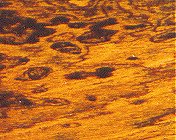 Bocote (Cordia eleagnoides)
Bocote (Cordia eleagnoides)
This wood grows in Latin America (Mexico), and was sold in this country under the name of "Rio Grande-palisander". The wood dealer told me it was destined for TV cabinets, but the TV factory went out of business, and he got stuck with the wood. I bought some of the wider pieces. It is used as a sustitute for Brazilian Rosewood, and even if the freshly cut wood is a greenish yellow and not very pleasant, (that includes the smell) it darkens with time to a nice, brown colour. The picture is a detail from my guitar #10, the one-of -a-kind pieces I used were flat-sawn, which gained a remarkable, leopard-like figure.
(Contents)
Cherry (Prunus avium)
For years I have collected the stems of old cherry trees. Many people feel that the European variety is finer than American cherry, which is usually the type you can see in furniture and kitchen cabinets. Until now I have used cherry for necks, but when I have my wood resawn, I plan to use it for backs and sides as well.
(Contents)
Ebony (Diospyros spp.)
The inner wood of ebony is ideally jet black (hence no picture), in practical life there is always some lighter or brown stripe. Ebony is growing among other places in Gabon and in Sri Lanka. It is my favourite wood for fingerboards and bridges. It contains less oils than rosewood, therefore it is easier to work than rosewood. Some people think that lighter stripe should be coloured black like the rest of the wood, but If i notice such a "fault" in my bridge blank, I prefer to use it actively, as a decorative element. At least you can see it is not made of black plastic.
(Contents)
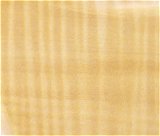 Horsechestnut (Aesculus hippocastanum)
Horsechestnut (Aesculus hippocastanum)
A relative of Buckeye, this tree grows in many parks in Norway. The wood resembles maple, but the medullary rays are not so prominent. Once I had the luck of having a huge stem for free at the noblest churchyard in Oslo (if I removed it, it took me two days!). It had nourished on the remnants of many a famous Norwegian, so maybe that's why it had grown so big and with such a nice flame! This electric guitar is made of horsechestnut and cherry. I also had a fiddle made of one of the best pieces. Here is a front view of the same fiddle. It is made by a fine violin maker and a friend of mine: Leif Salve Haakedal, N-4670 Birkeland. He makes all the modern instruments of the violin family, and also historic instruments and Hardanger fiddles, and usually the lacquer he uses is not quite as red!
(Contents)
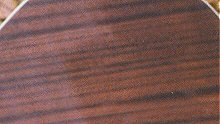 Mahogany (Switenia spp.)
Mahogany (Switenia spp.)
This is my favourite back/side material for steel string guitars, I just like the sound, somewhat warmer than you tend to get with rosewood. Because it is light, strong and a very stable wood, it is also the choice wood for necks. But alas, it is getting harder to get by, according to what I know, it is is not possible to grow in plantages because of fungus and insect attacks, so a lot of rainforest, maybe 500 trees must be cut to get access to one mahagany tree. Too bad! Real Honduras Mahogany is very scarce now. Sapele is an African wood that can be used as a replacement.
(Contents)
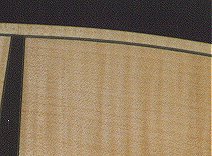 Maple (Acer spp.)
Maple (Acer spp.)
Maple has always been used as instrument wood, and European maple (Acer pseudoplatanus) is the choice wood for instruments of the violin family. But it is also widely used for guitar backs, sides and necks. There hardness varies a lot in the various maple species. It has prominent medullary rays that reflects the light in a very pleasant way in quartersawn material. The wood may also form waves or "flame" in various degrees, which is even nicer and much sought-after, and the prices are just sky high for the tightest and deepest flame! For us who have to consider economy, it is good to know that plain wood yields just as good results sound-wise!
(Contents)
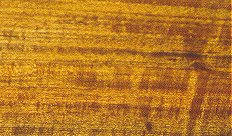 Mutenye (Guibourtia arnoldiana)
Mutenye (Guibourtia arnoldiana)
Back in the 70's in Trondheim there was an importer of exotic woods. (Once he created quite an uproar when in an ad in the local, conservative paper he was pictured in the jungle in tropical outfit among a group of pygmys proudly presenting their largest penis futterals and nothing more!). I got some nice wood there, and this particular wood would probably have ended up as flooring, had'nt I been there. It is very hard, and quite brittle, with a fine hue under laquer. In my guitars #9 and #12 I use this wood for backs and sides.
(Contents)
Redwood (latinsk navn)
This wood grows in a relatively limited area along the west coast of USA, and among its uses it also serves as soundboard for classical guitars. It is softer than spruce. I have got some sets with a quite hard and brittle variety that I have tried on my guitar #15 with promising result.
(Contents)
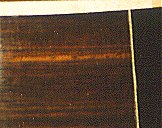 Rosewood (Dalbergia spp.)
Rosewood (Dalbergia spp.)
Brazilian Rosewood and later Indian Rosewood are the choice traditional wood for the backs and sides of acoustic guitars. Brazil launched an embargo on its rosewood long ago, so if there are some sets on the market they are so expensive it is no fun. Indian rosewood is still to be had at a reasonable price. It contains a lot of etheric oils that ruins the edge and collects on your tools, and it can dissolve and "bleed" under lacquer. As you see, I am not super enthusiastic about these woods, but no one can deny that they do look very nice!
(Contents)
Sitka spruce (Picea sitchensis)
This American tree of the spruce family is the most common wood for soundboards of steel string guitars. It has a bit more colour than European spruce, and the medullary rays are more prominent, coming into sight in quartersawn material. My guitar #6 has a Sitka spruce top, but I prefer to use European spruce in my guitars.
(Contents)
Spruce (Picea spp.)
Ideally, a guitar soundboard should weigh nothing, and still be able to stand the force of the strings, and woods of the spruce family is about as close as you get to this impossible goal. Spruce has been used for soundboards of musical instruments for centuries. European spruce of instrument quality grows in the Alps, but it is the same species that grows in Norway. But in this country you will have difficulties finding the large dimensions and the closeness of grain for a good guitar top. The problem is that the tree has to grow at a high altitude, in a shady slope with meagre soil, and it would have to be at least 200 years old to produce some nice guitar material. As the harvest cycle in Norwegian forestry is 70 to 80 years, it is evident that it is nearly impossible to find spruce suitable for instruments except in the most inaccessible places. But, if you are an adventurous and laboursome type, in my Norwegian version I describe how spruce for guitar tops can still be found in this country, especially if you can tolerate a three-piece top (after all, Torres made some three-piece tops!)
(Contents)
Western red cedar (Thuja occidentalis)
For soundboards of classical guitars, this is the most common wood. Its colour is less red than redwood, and it is a bit harder, but it varies. (I once tried a cedar top that was no stiffer sideways than thin cardboard). We have this tree in many Norwegian gardens, but they are unsuitable for instruments. The thing about the tight-grained guitar soundboard wood from the American forests is that they come from "old growth" trees, in forests which were left to themselves to grow for thousands of years. It will never be like this again, and alas, "second growth" trees of this and other species is not as suitable as soundboard material.
(Contents)